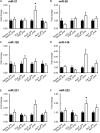MicroRNAs in Extracellular Vesicles in Sweat Change in Response to Endurance Exercise
- PMID: 32760282
- PMCID: PMC7373804
- DOI: 10.3389/fphys.2020.00676
MicroRNAs in Extracellular Vesicles in Sweat Change in Response to Endurance Exercise
Abstract
Background: To date, microRNAs (miRs) carried in extracellular vesicles (EVs) in response to exercise have been studied in blood but not in non-invasively collectable body fluids. In the present study, we examined whether six exercise-responsive miRs, miRs-21, -26, -126, -146, -221, and -222, respond to acute endurance exercise stimuli of different intensities in sweat.
Methods: We investigated the response of miRs isolated from sweat and serum EVs to three endurance exercise protocols: (1) maximal aerobic capacity (VO2 max ), (2) anaerobic threshold (AnaT), and (3) aerobic threshold (AerT) tests. Sauna bathing was used as a control test to induce sweating through increased body temperature in the absence of exercise. All protocols were performed by the same subjects (n = 8, three males and five females). The occurrence of different miR carriers in sweat and serum was investigated via EV markers (CD9, CD63, and TSG101), an miR-carrier protein (AGO2), and an HDL-particle marker (APOA1) with Western blot. Correlations between miRs in sweat and serum (post-sample) were examined.
Results: Of the studied miR carrier markers, sweat EV fractions expressed CD63 and, very weakly, APOA1, while the serum EV fraction expressed all the studied markers. In sweat EVs, miR-21 level increased after AerT and miR-26 after all the endurance exercise tests compared with the Sauna (p < 0.050). miR-146 after AnaT correlated to sweat and serum EV samples (r = 0.881, p = 0.004).
Conclusion: Our preliminary study is the first to show that, in addition to serum, sweat EVs carry miRs. Interestingly, we observed that miRs-21 and -26 in sweat EVs respond to endurance exercise of different intensities. Our data further confirmed that miR responses to endurance exercise in sweat and serum were triggered by exercise and not by increased body temperature. Our results highlight that sweat possesses a unique miR carrier content that should be taken into account when planning analyses from sweat as a substitute for serum.
Keywords: acute exercise response; circulating microRNA; leukocyte; sauna; serum.
Copyright © 2020 Karvinen, Sievänen, Karppinen, Hautasaari, Bart, Samoylenko, Vainio, Ahtiainen, Laakkonen and Kujala.
Figures




References
LinkOut - more resources
Full Text Sources
Other Literature Sources
Miscellaneous

